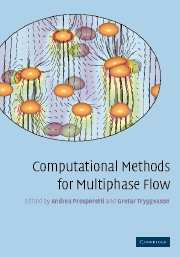Book contents
- Frontmatter
- Contents
- Preface
- Acknowledgments
- 1 Introduction: A computational approach to multiphase flow
- 2 Direct numerical simulations of finite Reynolds number flows
- 3 Immersed boundary methods for fluid interfaces
- 4 Structured grid methods for solid particles
- 5 Finite element methods for particulate flows
- 6 Lattice Boltzmann models for multiphase flows
- 7 Boundary integral methods for Stokes flows
- 8 Averaged equations for multiphase flow
- 9 Point-particle methods for disperse flows
- 10 Segregated methods for two-fluid models
- 11 Coupled methods for multifluid models
- References
- Index
9 - Point-particle methods for disperse flows
Published online by Cambridge University Press: 07 December 2009
- Frontmatter
- Contents
- Preface
- Acknowledgments
- 1 Introduction: A computational approach to multiphase flow
- 2 Direct numerical simulations of finite Reynolds number flows
- 3 Immersed boundary methods for fluid interfaces
- 4 Structured grid methods for solid particles
- 5 Finite element methods for particulate flows
- 6 Lattice Boltzmann models for multiphase flows
- 7 Boundary integral methods for Stokes flows
- 8 Averaged equations for multiphase flow
- 9 Point-particle methods for disperse flows
- 10 Segregated methods for two-fluid models
- 11 Coupled methods for multifluid models
- References
- Index
Summary
In the first chapters of this book we have seen methods suitable for a first-principles simulation of the interaction between a fluid and solid objects immersed in it. The associated computational burden is considerable and it is evident that those methods cannot handle large numbers of particles. In this chapter we develop an alternative approach which, while approximate, permits the simulation of thousands, or even millions, of particles immersed in a flow. The key feature which renders this possible is that the exchanges of momentum (and also possibly mass and energy) between the particle and the surrounding fluid are modeled, rather than directly resolved. This implies an approximate representation that is based on incorporating assumptions into the development of the mathematical model.
One of the most common approaches used today to model many particle-laden flows is based on the “point-particle approximation,” i.e. the treatment of individual particles as mathematical point sources of mass, momentum, and energy. This approximation requires an examination of the assumptions and limitations inherent to this approach, aspects that are given consideration in this chapter. Point-particle methods have relatively wide application and have proven a useful tool for modeling many complex systems, especially those comprised of a very large ensemble of particles. Details of the numerical aspects inherent to point-particle treatments are highlighted.
We start by putting point-particle methods into the context established earlier in this text and, in particular, in the previous chapter.
Information
- Type
- Chapter
- Information
- Computational Methods for Multiphase Flow , pp. 282 - 319Publisher: Cambridge University PressPrint publication year: 2007
Accessibility standard: Unknown
Why this information is here
This section outlines the accessibility features of this content - including support for screen readers, full keyboard navigation and high-contrast display options. This may not be relevant for you.Accessibility Information
- 6
- Cited by
